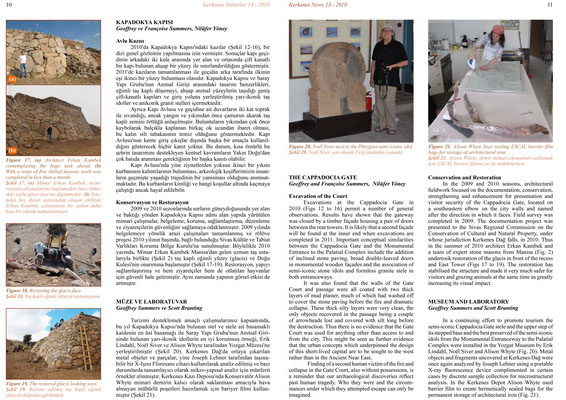| |
THE CAPPADOCIA GATE
Geoffrey and Françoise Summers, Nilüfer Yöney
Excavation of the Court
Excavations at the Cappadocia Gate in 2010 (Figs 12 to 16) permit a number of general observations. Results have shown that the gateway was closed by a timber façade housing a pair of doors between the rear towers. It is likely that a second façade will be found at the inner end when excavations are completed in 2011. Important conceptual similarities between the Cappadocia Gate and the Monumental Entrance to the Palatial Complex include the addition of inclined stone paving, broad double-leaved doors in monumental wooden façades and the association of semi-iconic stone idols and formless granite stele in both entranceways.
It was also found that the walls of the Gate Court and passage were all coated with two thick layers of mud plaster, much of which had washed off to cover the stone paving before the fire and dramatic collapse. These thick silty layers were very clean, the only objects recovered in the passage being a couple of arrowheads lost and covered with silt long before the destruction. Thus there is no evidence that the Gate Court was used for anything other than access to and from the city. This might be seen as further evidence that the urban concepts which underpinned the design of this short-lived capital are to be sought to the west rather than in the Ancient Near East.
Finding of a second human victim of the fire and collapse in the Gate Court, also without possessions, is a reminder that our archaeological discoveries reflect past human tragedy. Who they were and the circumstances under which they attempted escape can only be imagined.
Conservation and Restoration
In the 2009 and 2010 seasons, architectural fieldwork focused on the documentation, conservation, strengthening and enhancement for presentation and visitor security of the Cappadocia Gate, located on a southeastern elbow on the city walls and named after the direction in which it faces. Field survey was completed in 2009. The documentation project was presented to the Sivas Regional Commission on the Conservation of Cultural and Natural Property, under whose jurisdiction Kerkenes Dağ falls, in 2010. Thus in the summer of 2010 architect Erkan Kambek and a team of expert stone masons from Manisa (Fig. 2) undertook restoration of the glacis in front of the recess and East Tower (Figs 17 to 19). The restoration has stabilised the structure and made it very much safer for visitors and grazing animals at the same time as greatly increasing its visual impact.
MUSEUM AND LABORATORY
Geoffrey Summers and Scott Branting
In a continuing effort to promote tourism the
semi-iconic Cappadocia Gate stele and the upper step of
its stepped base and the best preserved of the semi-iconic
idols from the Monumental Entranceway to the Palatial
Complex were installed in the Yozgat Museum by Erik
Lindahl, Noël Siver and Alison Whyte (Fig. 20). Metal
objects and fragments uncovered at Kerkenes Dağ were
once again analyzed by Joseph Lehner using a portable
X-ray fluorescence device complimented in certain
cases by discrete sample collection for microstructural
analysis. In the Kerkenes Depot Alison Whyte used
barrier film to create hermetically sealed bags for the
permanent storage of architectural iron (Fig. 21).
|



